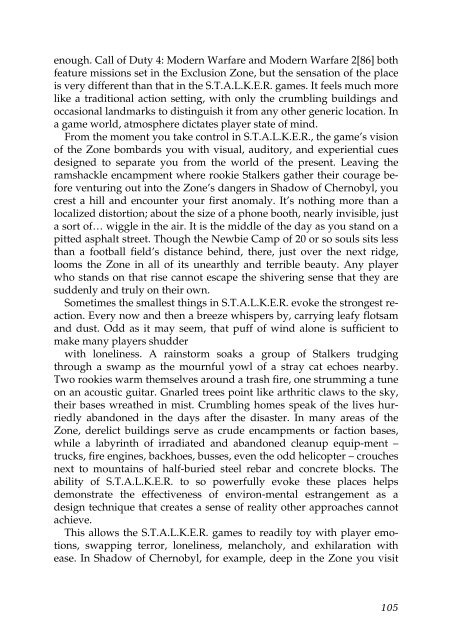Well Played 2.0: Video Games, Value and Meaning - OpenLibra
Well Played 2.0: Video Games, Value and Meaning - OpenLibra
Well Played 2.0: Video Games, Value and Meaning - OpenLibra
You also want an ePaper? Increase the reach of your titles
YUMPU automatically turns print PDFs into web optimized ePapers that Google loves.
enough. Call of Duty 4: Modern Warfare <strong>and</strong> Modern Warfare 2[86] both<br />
feature missions set in the Exclusion Zone, but the sensation of the place<br />
is very different than that in the S.T.A.L.K.E.R. games. It feels much more<br />
like a traditional action setting, with only the crumbling buildings <strong>and</strong><br />
occasional l<strong>and</strong>marks to distinguish it from any other generic location. In<br />
a game world, atmosphere dictates player state of mind.<br />
From the moment you take control in S.T.A.L.K.E.R., the game’s vision<br />
of the Zone bombards you with visual, auditory, <strong>and</strong> experiential cues<br />
designed to separate you from the world of the present. Leaving the<br />
ramshackle encampment where rookie Stalkers gather their courage before<br />
venturing out into the Zone’s dangers in Shadow of Chernobyl, you<br />
crest a hill <strong>and</strong> encounter your first anomaly. It’s nothing more than a<br />
localized distortion; about the size of a phone booth, nearly invisible, just<br />
a sort of… wiggle in the air. It is the middle of the day as you st<strong>and</strong> on a<br />
pitted asphalt street. Though the Newbie Camp of 20 or so souls sits less<br />
than a football field’s distance behind, there, just over the next ridge,<br />
looms the Zone in all of its unearthly <strong>and</strong> terrible beauty. Any player<br />
who st<strong>and</strong>s on that rise cannot escape the shivering sense that they are<br />
suddenly <strong>and</strong> truly on their own.<br />
Sometimes the smallest things in S.T.A.L.K.E.R. evoke the strongest reaction.<br />
Every now <strong>and</strong> then a breeze whispers by, carrying leafy flotsam<br />
<strong>and</strong> dust. Odd as it may seem, that puff of wind alone is sufficient to<br />
make many players shudder<br />
with loneliness. A rainstorm soaks a group of Stalkers trudging<br />
through a swamp as the mournful yowl of a stray cat echoes nearby.<br />
Two rookies warm themselves around a trash fire, one strumming a tune<br />
on an acoustic guitar. Gnarled trees point like arthritic claws to the sky,<br />
their bases wreathed in mist. Crumbling homes speak of the lives hurriedly<br />
ab<strong>and</strong>oned in the days after the disaster. In many areas of the<br />
Zone, derelict buildings serve as crude encampments or faction bases,<br />
while a labyrinth of irradiated <strong>and</strong> ab<strong>and</strong>oned cleanup equip-ment –<br />
trucks, fire engines, backhoes, busses, even the odd helicopter – crouches<br />
next to mountains of half-buried steel rebar <strong>and</strong> concrete blocks. The<br />
ability of S.T.A.L.K.E.R. to so powerfully evoke these places helps<br />
demonstrate the effectiveness of environ-mental estrangement as a<br />
design technique that creates a sense of reality other approaches cannot<br />
achieve.<br />
This allows the S.T.A.L.K.E.R. games to readily toy with player emotions,<br />
swapping terror, loneliness, melancholy, <strong>and</strong> exhilaration with<br />
ease. In Shadow of Chernobyl, for example, deep in the Zone you visit<br />
105

















